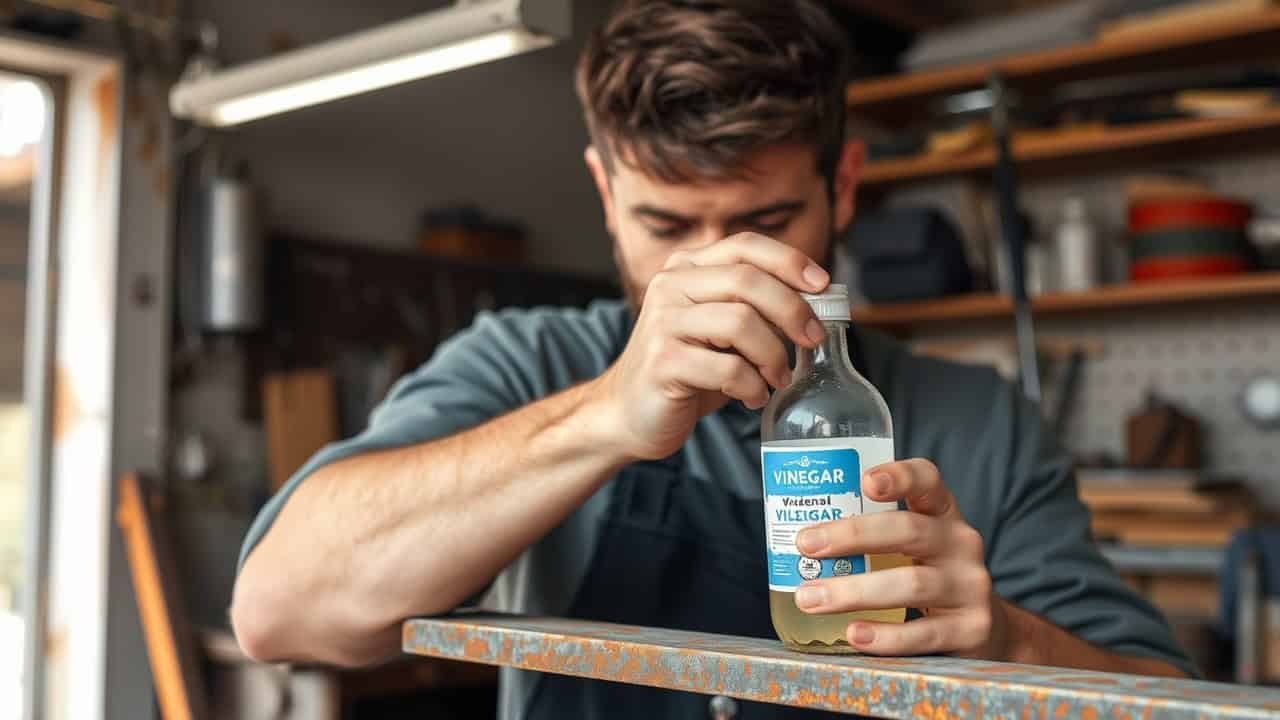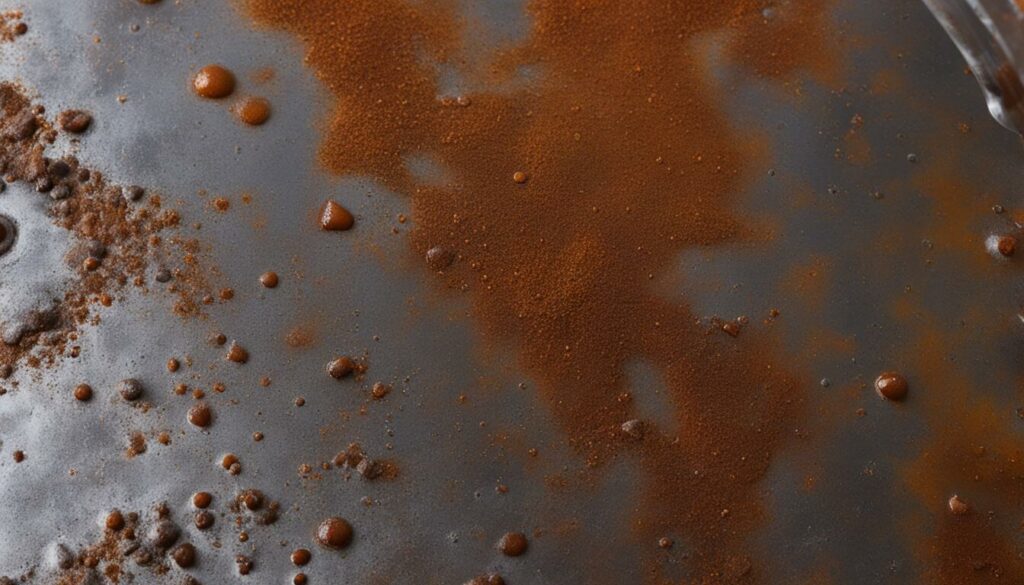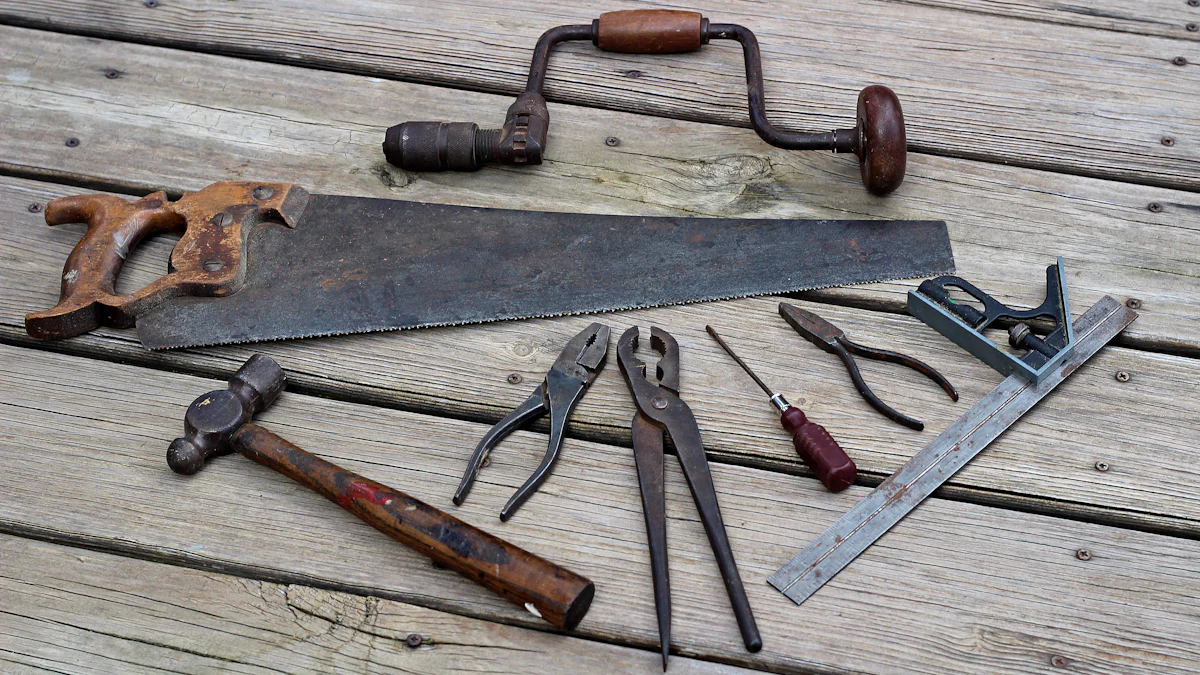
Ever wondered how to remove rust from metal? Rust forms when iron, water, and oxygen interact, creating a pesky problem on metal surfaces. Removing rust is important to keep your metal objects looking sharp and lasting longer. Ignoring it can lead to irreversible damage.
In this post, we will show you how to do that. From baking soda to lemon and salt, these methods are your ally in removing rust from metal objects. Whether you’re dealing with stainless steel or other metal, these techniques will help you remove rust effectively.
Method 1: Using White Vinegar
Have you ever wondered how something as simple as white vinegar can tackle stubborn rust? It’s a household staple that packs a punch against rust. Let’s dive into how you can use it effectively.
Detailed Instruction
Step-by-step process
-
Gather Your Supplies: You’ll need white vinegar, a bowl, and a scrubbing tool like a wire brush or steel wool.
-
Submerge the Item: Place the rusty metal item in a bowl and pour enough white vinegar to cover it completely.
-
Soak Overnight: Let the item soak in the vinegar overnight. This gives the acid in the vinegar time to break down the rust.
-
Scrub Away the Rust: After soaking, use your wire brush or steel wool to scrub off the rust. You might need to apply some elbow grease for stubborn spots.
-
Repeat if Necessary: For tough rust, you may need to repeat the soaking and scrubbing process.
-
Rinse and Dry: Once the rust is gone, rinse the item with water and soap, then dry it thoroughly to prevent new rust from forming.
Duration and frequency
-
Duration: The soaking process typically takes about 12 hours, but for severe rust, you might need up to 24 hours.
-
Frequency: Use this method as needed, especially when you notice rust starting to form.
Tools Required
List of necessary items
-
White Vinegar: The star of the show.
-
Bowl: To hold the vinegar and the item.
-
Wire Brush or Steel Wool: For scrubbing off the rust.
-
Soap and Water: For cleaning after rust removal.
Who Should Try This?
Suitable for DIY enthusiasts
If you love tackling projects around the house, this method is perfect for you. It’s simple, cost-effective, and uses items you likely already have in your kitchen. Plus, it’s a great way to breathe new life into your metal tools and objects without harsh chemicals.
Who Should Not Try This?
Not recommended for large-scale projects
White vinegar works wonders for small rust removal tasks. However, if you’re dealing with large-scale projects, this method might not be your best bet. Imagine trying to soak a large metal gate or a car part in a bowl of vinegar. It’s impractical and time-consuming.
For extensive rust issues, consider using commercial rust removers or professional services that can handle bigger jobs efficiently.
Common Mistake to Avoid
Over-soaking the metal
You might think that leaving your metal item in vinegar for longer will yield better results. But over-soaking can actually damage the metal. The acid in vinegar, while effective at removing rust, can also start to eat away at the metal itself if left too long.
Stick to the recommended soaking time, usually overnight, and check the progress before deciding to soak it longer.
Potential Challenges
Vinegar smell
One thing you might notice when using vinegar is its strong smell. While it’s not harmful, the odor can be quite overpowering, especially if you’re working indoors.
To minimize this, ensure good ventilation in your workspace. Open windows or use a fan to help disperse the smell. If the odor lingers on the metal item, a thorough rinse with soap and water should help eliminate it.
Any Safety Concerns?
Skin irritation precautions
When using white vinegar to remove rust, you might wonder if there are any safety concerns. While vinegar is a natural and generally safe household item, it’s always wise to take some precautions to protect your skin. Here’s what you need to know:
-
Wear Gloves: When handling vinegar, especially for extended periods, wearing gloves can help prevent skin irritation. Vinegar is acidic, and prolonged exposure might cause dryness or irritation to sensitive skin.
-
Ventilation is Key: The strong smell of vinegar can be overwhelming. Ensure you’re working in a well-ventilated area. Open windows or use a fan to keep the air circulating. This will help disperse the odor and make the process more comfortable.
-
Avoid Eye Contact: Be cautious not to splash vinegar into your eyes. If it happens, rinse your eyes immediately with plenty of water. Wearing safety goggles can provide an extra layer of protection.
-
Rinse Thoroughly: After removing rust, make sure to rinse the metal item thoroughly with water and soap. This step not only removes any remaining vinegar but also helps eliminate the smell.
By following these simple precautions, you can safely and effectively use vinegar to tackle rust on your metal items. Remember, a little care goes a long way in ensuring a smooth and irritation-free rust removal process.
Method 2: Baking Soda Paste
Ever thought about using baking soda to tackle rust? It’s a simple and effective method that you can easily try at home. Let’s dive into how you can make this work for you.
Detailed Instruction
Mixing and application
-
Create the Paste: Mix baking soda with water until you get a thick paste. You want it to be spreadable but not too runny.
-
Apply the Paste: Spread the paste over the rusty areas. Make sure to cover all the spots you want to treat.
-
Let It Sit: Allow the paste to sit on the rust for about an hour. This gives it time to break down the rust particles.
Rinsing and drying
-
Scrub the Area: Use a brush or sponge to scrub the rust away. Apply some pressure to ensure the rust comes off.
-
Rinse Thoroughly: Wash the metal with water to remove any remaining paste.
-
Dry Completely: Make sure to dry the item thoroughly to prevent new rust from forming.
Tools Required
Common household items
-
Baking Soda: The main ingredient for the paste.
-
Water: To mix with the baking soda.
-
Brush or Sponge: For scrubbing the rust.
-
Towel: For drying the metal item.
Who Should Try This?
Ideal for small rust spots
If you’re dealing with small rust spots, this method is perfect for you. It’s gentle on the metal and easy to do with items you already have at home. Plus, it’s a great way to keep your metal items looking fresh without harsh chemicals.
Who Should Not Try This?
Ineffective for deep rust
If you’re dealing with deep or extensive rust, baking soda might not be your best bet. This method works wonders on surface rust but struggles with more severe cases. You might find yourself scrubbing endlessly without seeing much improvement.
For deeper rust, consider using a stronger method like commercial rust removers.
Common Mistake to Avoid
Incorrect paste consistency
Getting the right consistency for your baking soda paste is crucial. Too runny, and it won’t stick to the rust; too thick, and it might not penetrate effectively. Aim for a spreadable texture, similar to toothpaste. This ensures the paste clings to the rust and does its job efficiently.
Potential Challenges
Time-consuming process
Patience is key with this method. Baking soda takes time to break down rust, so don’t expect instant results. You might need to let the paste sit for an hour or more.
If you’re in a hurry, this process might feel slow. However, the gentle nature of baking soda makes it worth the wait for small rust spots.
Any Safety Concerns?
Minimal, safe for most users
When you think about using baking soda to remove rust, safety might not be your first concern. And that’s a good thing! Baking soda is a gentle and non-toxic option for rust removal. You can feel confident using it without worrying about harsh chemicals or dangerous reactions.
Here are some tips to ensure a smooth and safe experience:
-
Skin-Friendly: Baking soda is mild on the skin. You won’t need gloves unless you have sensitive skin or cuts. If you do, wearing gloves can prevent any irritation.
-
No Harmful Fumes: Unlike some commercial rust removers, baking soda doesn’t release harmful fumes. You can work indoors without needing special ventilation. This makes it a great choice for small projects at home.
-
Easy Cleanup: After using baking soda, cleaning up is a breeze. Just rinse the metal item with water and dry it thoroughly. There’s no need for special disposal methods or worry about environmental harm.
-
Child and Pet Safe: If you have kids or pets around, baking soda is a safe option. You won’t have to worry about accidental exposure to toxic substances.
- https://www.youtube.com/watch?v=sVJOwLjHYfc
Method 3: Lemon and Salt
Ever thought about using lemon and salt to tackle rust? This method is not only effective but also eco-friendly. Let’s explore how you can use these common kitchen items to remove rust from metal surfaces.

Detailed Instruction
Application and Scrubbing
-
Gather Your Supplies: You’ll need a lemon, some salt, and a scrubbing tool like a soft cloth or brush.
-
Apply the Salt: Sprinkle a generous amount of salt over the rusty area. The salt acts as an abrasive to help scrub away the rust.
-
Add Lemon Juice: Cut the lemon in half and squeeze the juice over the salt-covered rust. The acid in the lemon helps break down the rust particles.
-
Scrub the Rust: Use your cloth or brush to scrub the area. Apply pressure to ensure the rust comes off. You might need to repeat this step for stubborn spots.
Rinsing Process
-
Rinse Thoroughly: Wash the metal with water to remove any remaining lemon juice and salt.
-
Dry Completely: Make sure to dry the item thoroughly to prevent new rust from forming.
Tools Required
Basic Kitchen Supplies
-
Lemon: Acts as a natural acid.
-
Salt: Provides abrasion.
-
Cloth or Brush: For scrubbing.
-
Water: For rinsing.
Who Should Try This?
Eco-Friendly Option Seekers
If you’re looking for a natural and environmentally friendly way to remove rust, this method is perfect for you. It’s safe, simple, and uses ingredients you probably already have at home.
Plus, it’s a great way to avoid harsh chemicals while still achieving effective results.
Who Should Not Try This?
Not for severe rust cases
If you’re dealing with heavy rust, lemon and salt might not cut it. This method shines for light rust but struggles with deeper corrosion. You might find yourself scrubbing endlessly without much progress.
For severe rust, consider stronger solutions like commercial rust removers.
Common Mistake to Avoid
Using too much salt
You might think more salt equals better results. However, too much can scratch the metal surface. Aim for a balanced amount.
The salt should cover the rust but not overwhelm it. This ensures effective rust removal without damaging your item.
Potential Challenges
Requires elbow grease
Be ready to put in some effort. This method needs a bit of muscle power. The scrubbing can be tiring, especially for larger areas. But the natural ingredients make it worth the effort. You’ll get a workout and a rust-free item!
Any Safety Concerns?
Safe, natural ingredients
Have you ever wondered if using lemon and salt to remove rust is safe? You’re in luck! This method uses natural ingredients that are gentle on both you and the environment.
-
Skin-Friendly: Lemon juice and salt are common kitchen items. They’re safe to handle without gloves. If you have sensitive skin, you might want to wear gloves to avoid any irritation from the acidity of the lemon.
-
No Harmful Fumes: Unlike some chemical rust removers, lemon and salt don’t release harmful fumes. You can work indoors without worrying about ventilation. This makes it a great choice for small projects at home.
-
Eco-Friendly: Using natural ingredients means you’re not introducing harsh chemicals into the environment. It’s a win-win for you and the planet!
-
Easy Cleanup: After using lemon and salt, simply rinse the metal item with water. There’s no need for special disposal methods. Just make sure to dry the item thoroughly to prevent new rust from forming.
By choosing lemon and salt, you’re opting for a safe and effective way to tackle rust. Enjoy the peace of mind that comes with using natural solutions!
Method 4: Commercial Rust Removers
Ever found yourself in a rush to get rid of rust? Commercial rust removers might be your go-to solution. These products offer quick and efficient results, perfect for those who need a fast fix.
Detailed Instruction
Product Application
-
Choose the Right Product: Select a commercial rust remover that suits your needs. Read the label to ensure it’s appropriate for your metal type.
-
Prepare the Area: Clean the metal surface to remove dirt and debris. This helps the product work more effectively.
-
Apply the Remover: Follow the instructions on the product label. Usually, you’ll apply it directly to the rusted area using an applicator or cloth.
-
Wait and Observe: Allow the product to sit for the recommended time. This lets the chemicals break down the rust.
-
Rinse and Dry: After the rust is gone, rinse the metal thoroughly with water. Dry it completely to prevent new rust from forming.
Follow-up Care
-
Inspect Regularly: Check the metal periodically to catch any new rust early.
-
Apply a Protective Coating: Consider using a rust-preventive spray or paint to protect the metal.
Tools Required
Specific Product and Applicator
-
Commercial Rust Remover: Choose a product that matches your needs.
-
Applicator: Use a brush or cloth as directed by the product instructions.
-
Water and Towel: For rinsing and drying the metal.
Who Should Try This?
Those Needing Quick Results
If you’re in a hurry or dealing with extensive rust, commercial rust removers are ideal. They provide fast and effective results, saving you time and effort. Perfect for those who want a hassle-free solution without the wait.
Using commercial rust removers can be a game-changer for tackling rust quickly.
Just remember to follow the instructions carefully and take the necessary precautions to protect your metal items.
Who Should Not Try This?
Budget-conscious individuals
If you’re watching your wallet, commercial rust removers might not be the best choice for you. These products can be pricey, especially if you need them frequently or for large projects. You might find that DIY methods, like using baking soda or lemon and salt, offer a more cost-effective solution.
These alternatives use ingredients you likely already have at home, saving you money while still effectively tackling rust.
Common Mistake to Avoid
Ignoring product instructions
You might think you know how to use a rust remover, but skipping the instructions can lead to problems. Each product has specific guidelines for application and safety. Ignoring these can result in ineffective rust removal or even damage to your metal items.
Always read and follow the instructions on the label. This ensures you get the best results and keep your items safe.
Potential Challenges
Product availability
Finding the right rust remover can sometimes be a challenge. Not all stores carry a wide range of options, and you might need to shop around or order online. This can delay your project, especially if you’re in a hurry.
Consider having a backup plan, like trying a DIY method, in case your preferred product isn’t available. This way, you can still tackle rust without waiting for a specific product to arrive.
Any Safety Concerns?
Chemical Handling Precautions
When using commercial rust removers, safety should be your top priority. These products contain chemicals that can be harsh if not handled properly. Here’s how you can stay safe:
-
Read the Label: Always start by reading the product label. It provides essential information on how to use the remover safely and effectively.
-
Wear Protective Gear: Equip yourself with gloves and safety goggles. This protects your skin and eyes from potential irritation or harm.
-
Ensure Proper Ventilation: Use these products in a well-ventilated area. Open windows or use fans to disperse any fumes, keeping the air fresh and breathable.
-
Avoid Mixing Chemicals: Never mix different rust removers or combine them with other cleaning agents. This can cause dangerous reactions.
-
Store Safely: Keep rust removers out of reach of children and pets. Store them in a cool, dry place to maintain their effectiveness and safety.
By following these precautions, you can confidently use commercial rust removers without compromising your safety. Remember, a little care goes a long way in ensuring a smooth and hazard-free rust removal process.
Method 5: Sandpaper or Steel Wool

Have you ever wondered how to tackle rust on metal surfaces with just a bit of elbow grease? Sandpaper and steel wool might be your answer. These tools offer a hands-on approach to rust removal, perfect for those who enjoy a bit of DIY action.
Detailed Instruction
Sanding Technique
-
Select the Right Grit: Start with coarse sandpaper (around 80-grit) to tackle heavy rust. As you progress, switch to finer grits (up to 220-grit) for a smoother finish.
-
Prepare the Surface: Clean the metal surface to remove any dirt or debris. This ensures the sandpaper can work effectively.
-
Sand the Rust: Use firm, even strokes to sand the rusted area. Apply consistent pressure, but be careful not to over-sand, which can damage the metal.
-
Check Your Progress: Periodically wipe away dust to check your progress. This helps you see if more sanding is needed.
Finishing Touches
-
Switch to Steel Wool: For a polished finish, use fine-grade steel wool. It helps smooth out any remaining rough spots.
-
Clean the Surface: Wipe the metal with a damp cloth to remove any sanding residue.
-
Dry Thoroughly: Ensure the metal is completely dry to prevent new rust from forming.
Tools Required
Sandpaper Grades, Steel Wool
-
Coarse Sandpaper (80-grit): For initial rust removal.
-
Fine Sandpaper (220-grit): For smoothing the surface.
-
Steel Wool: For a polished finish.
-
Cloth: For cleaning and drying.
Who Should Try This?
Hands-on DIYers
If you love getting your hands dirty and enjoy a bit of manual labor, this method is for you. Sandpaper and steel wool offer a tactile experience, allowing you to feel the progress as you work. It’s a satisfying way to restore metal items, especially if you appreciate the art of hands-on craftsmanship.
Plus, it’s a great workout for your arms!
Using sandpaper or steel wool to remove rust is a straightforward and effective method. It requires some effort, but the results can be incredibly rewarding. Just remember to take your time and enjoy the process.
Who Should Not Try This?
Those with delicate items
If you’re dealing with delicate metal items, sandpaper or steel wool might not be the best choice. These tools can be abrasive and may scratch or damage fragile surfaces. For items like fine jewelry or thin metal pieces, consider gentler methods like using baking soda or lemon juice.
These alternatives provide a softer touch while still effectively removing rust.
Common Mistake to Avoid
Over-sanding
You might think that more sanding equals better results, but over-sanding can actually harm your metal. It’s important to use the right grit and apply even pressure. Start with coarse sandpaper to remove heavy rust, then switch to finer grits for a smooth finish.
Always check your progress to avoid sanding away too much material.
Potential Challenges
Physical effort required
Be prepared to put in some elbow grease. Sanding rust off metal requires physical effort, especially for larger areas. It’s a hands-on process that can be tiring, but the results are rewarding.
If you enjoy a bit of DIY action and don’t mind the workout, this method can be both effective and satisfying. Just remember to take breaks and pace yourself to avoid fatigue.
Any Safety Concerns?
Protective Gear Recommended
When you’re tackling rust with sandpaper or steel wool, safety should be a top priority. These tools can be abrasive, so it’s essential to protect yourself. Here’s how you can stay safe:
-
Wear Gloves: Protect your hands from scratches and irritation. Sandpaper and steel wool can be rough on the skin, so gloves are a must.
-
Use Eye Protection: Tiny metal particles can fly off during sanding. Safety goggles will keep your eyes safe from debris.
-
Work in a Well-Ventilated Area: Dust can accumulate quickly. Ensure good airflow to avoid inhaling particles. Open windows or use a fan to keep the air fresh.
-
Consider a Dust Mask: If you’re working on a large project, a dust mask can prevent inhalation of fine particles. It’s a simple step that adds an extra layer of protection.
By following these precautions, you can enjoy a safe and effective rust removal process. Remember, taking care of yourself is just as important as taking care of your metal items!
Summing Up
You’ve now got five effective methods to tackle rust on metal surfaces. Whether you choose white vinegar, baking soda, lemon and salt, commercial rust removers, or sandpaper, each method offers unique benefits.
Remember, baking soda works wonders on light rust stains and thin metals. For prevention, keep your metal items dry and consider applying a protective coating. Don’t let rust intimidate you.
Try these methods and see which one suits your needs best.
Happy rust-busting!

Dave Johnson is a mechanical engineer with over two decades of experience in the semiconductor industry. He’s known for his exceptional ability to fix almost any mechanical and electronic device, from leaking faucets to lawnmowers – he is definitely your go-to neighbor for household maintenance issues. When he’s not elbow-deep in his garage doing household repairs, you’ll find him sharing his expertise on fixing everyday maintenance challenges on this site.

